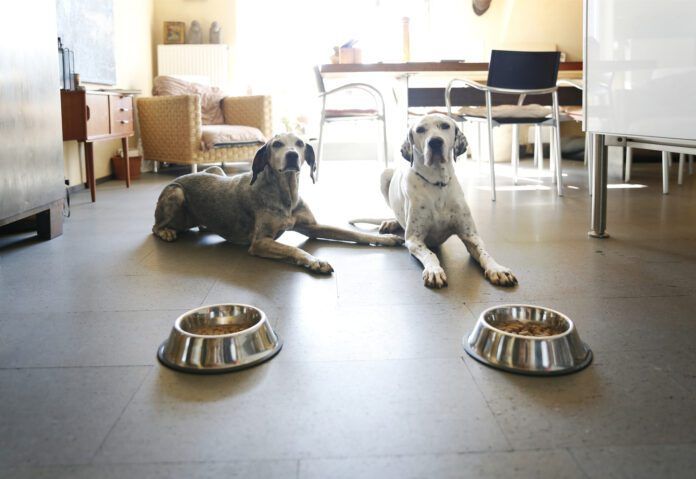How to switch dog food depends a bit on what you’re switching to or from. For example, if your dog suffers from a simple digestive upset with vomiting and/or diarrhea, your veterinarian may recommend that you feed a bland diet for a few days—without a transition period.
But, if you’ve simply decided to change his everyday dog food to a different one, it’s best to transition it over the course of a week or so. If you switch your dog’s food without transitioning, he may experience a gastrointestinal (GI) tract upset in the form of vomiting, diarrhea, and an understandable lack of appetite.
Slow Transition
A gradual switch is recommended by most veterinarians when you’re changing dog food for any reason (except bland, as stated). That said, if your dog is used to a constant variety of dog food, as has been recommended by Whole Dog Journal, he may not require a transition. Many dogs can eat a wide variety of ingredients and foods and will tolerate a rotational diet, provided the protein and fat levels of the foods you’re choosing are similar.
“Often there are more problems from a GI perspective if the nutrient composition changes a lot, let’s say a 10% fat diet and then they try a 20% diet,” says Joseph Wakshlag DVM, professor in the department of clinical sciences at Cornell University’s College of Veterinary Medicine in the Cornell DogWatch newsletter. Switching abruptly to a richer diet can cause problems, particularly diarrhea. And dogs with more sensitive stomachs are even more likely to experience GI upset when their diet is changed abruptly.
The general veterinary recommendation is that, if your dog has been eating the same food right along, and you are now transitioning from one regular maintenance diet to another for whatever reason, a week-long transition helps the GI microbiome adjust.
Start your transition before you run out of the old food and do 3 parts old to 1 part new for two to three days, then 50:50 for two to three days, then 3 parts new to 1 part old for two to three days. After that, you should be able to feed 100% new food. In this scenario, the transition period spans seven to 10 days (see chart).
Bland Diet Transition
A switch to a temporary bland diet, which is often recommended for dogs battling diarrhea and/or vomiting, does not require transition. These diets are always low in fat and easy to digest, allowing your dog’s GI tract to rest and heal. Once the dog’s symptoms have resolved, a gradual transition back to his regular food is recommended to avoid abruptly shocking the recovering gut lining with richer ingredients.
The first day you start the transition from the bland diet back to your dog’s normal food, make each meal 3 parts bland diet to 1 part regular diet. If there’s no return of symptoms, the next day make each meal a 50:50 mix of bland and regular. If so far so good, the third day each meal is 1 part bland to 3 parts regular. If all is still well, your dog can return to full regular feedings on the fourth day. Note: If your dog has a super sensitive stomach, follow the same idea, but make changes every two days instead of every day. In this case, it will be a full week before your dog is back to full regular feedings.
Dog Food Transition Chart
This chart shows a one-week course of gradually transitioning your dog’s food to a new variety.
| Day | Percentage Old Food | Percentage New Food | Comments |
|---|---|---|---|
| 1 | 75% | 25% | |
| 2 | 75% | 25% | |
| 3 | 75% | 25% | If he’s doing well, you can move to two days of 50-50 on this day. |
| 4 | 50% | 50% | |
| 5 | 50% | 50% | If he shows any signs of difficulty, like loose stools, do three days of 50-50. |
| 6 | 25% | 75% | |
| 7 | 25% | 75% | Continue for another day or two, if needed. |






